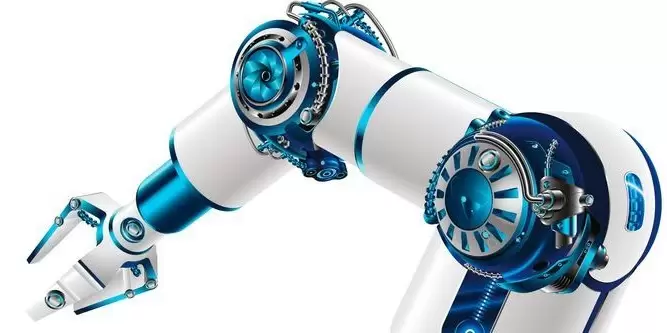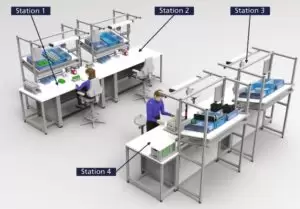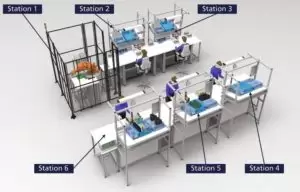
Views: 273
Robotic systems are the trend – more and more companies rely on automated helpers. But when buying an industrial robot is it worth it?
Original Article Elektrotechnik: Industrial robot offer many advantages for companies – they work quickly, reliably and are fail-safe. But with a robotic system, new costs also come to a company. In addition to the obvious cost, there are many long-term costs to consider. But when is a company worth using a robotic system?
Buy industrial robots – what should be considered?
To understand if the purchase is really worth it, it is important to compare the entire flexible factory resulting with a conventional production without robots. In addition to the acquisition costs of the robot, the costs of peripheral equipment and adaptations to existing machines, as well as installation costs, are particularly important for the company. Planning, commissioning, operation, maintenance and repair also cost money. The return periods of the robotic systems are from 3 to 4 years – only then the new system is worth it.
Economy of robotic systems
In addition to the direct costs, the qualitative aspects should also be included in the evaluation of an automated system. The user must also consider the flexibility of the robot: not only can a robot be used for a single application, but it can also be used for other tasks when converting production. The reuse of a robot and parts of the periphery generally significantly reduces capital outlays for new production facilities, so that the profitability of robotic systems compared to conventional systems is often apparent only during a production change or a change of model . Next, several methods of investment and cost accounting are shown and illustrated by an example.
What are the costs of the robots?
As robotic systems are generally installed in a production area, a division of costs according to the operating area does not add value to the comparison of said systems. The individual components can continue to be used during a product change. Thus, costs are relevant throughout the life cycle and systems can be better compared by a decomposition of costs according to the costs of acquisition, operation and recycling. The individual cost types can then be subdivided.
The cost of acquisition: what does a robot cost?
With the acquisition costs, the individual components can be considered individually or groups of components can be formed. In this way, the cost of the robots can be compared with the cost of the peripherals. In addition, the cost of individual components of a robot system, z. As security technology, material flow systems, sensors, end effectors, facing each other and thus the optimization potential can be visible.
The cost of the robot itself is only a small fraction of the total cost. The investment costs for the robot are mainly influenced by its characteristics. These include load capacity, range and precision. In addition, the number of axes has an impact on the cost of a robot. Detailed formulas for calculating acquisition costs can be found in the Industrial Robotics book, from which this article is extracted.
Operating costs
On the one hand, operating costs are divided into maintenance costs of cost types, room costs, energy costs, consumables and supplies costs, personnel costs and tool costs. These costs are highly dependent on the production process and not on the characteristics of the system. As a result, it may happen that operating costs vary greatly during the period of use. On the other hand, operating costs also include material costs, configuration, storage and disposal. These are strongly dependent on the manufactured product and, therefore, are not described in detail. However, they must be taken into account in the calculation.
The planned maintenance costs include maintenance, inspection and repair costs. They are influenced by the type, duration and frequency of maintenance measures. The maintenance also influences the probability of an unplanned failure of the machines. As a result, planned maintenance is subject to the compromise between high system availability and low maintenance costs. To determine the maintenance costs, relevant indexes are needed for the reliability of the installed components. For a first approach, maintenance costs can be calculated by a factor. A typical value for annual maintenance costs is 10% of the acquisition costs of the system.
The costs of the room are greatly influenced by the design of the robot system and the necessary space requirements. The space requirement is defined by the handling device and its scope and the space required for the necessary peripherals. By connecting the end effector to the robot, its workspace falls on the robot’s. The material flow and the implementation strategy and the necessary equipment have a great impact on the space requirements. If the robot system is surrounded by a protective fence, the area within that fence can be used for the required space requirement. However, peripherals located outside that area should not be neglected.
The energy costs of a robotic system include the costs of electricity and compressed air and are influenced by the energy consumption of the individual components of the system and their lifetimes. Energy costs are not constant over the lifetime. The main consumers of electricity in an automated system are robots and controls, as well as equipment related to the application, for example, when you release the welding table, welding power supply or transformer and the laser. In practice, the robot’s energy consumption depends on the size, range, load, acceleration and travel speed.
The costs of consumables and supplies result from the efficiency of the respective components and processes in the production task. When welding gas welded metal arc is mainly the consumption of inert gas and welding wire to call. The consumption of cooling water can be omitted with appropriate recycling systems. For the cleaning of the burner nozzles, a release agent is necessary.
Personnel costs depend, on the one hand, on the number of employees required and on their level of training and, on the other hand, on working time. The costs refer to the entire robot system and not to individual components. Personnel costs are divided mainly into the two areas of programming and operation. Highly automated systems do not require operational personnel. You just need to be present for some employees of the factories who can intervene in case of failure. In semi-automated systems, however, employees must be used, the z. B. provide the robot with individual parts.
The costs of the tools are especially incurred in the applications in which a manufacturing process is carried out using the robot. Welding requires a variety of welding nozzles or electrodes. When milling with the robot, the milling tools – as with a machine tool – must be replaced after reaching a wear limit. With parallel jaw claws, there are no tool costs in addition to acquisition costs. With suction cups, it may be necessary to replace the individual suction cups.
Recovery costs
The recovery phase is divided into two areas of sale of the system or recovery in the form of recycling or discarding. The flexibility of the system influences the residual value. The more flexible a system, the higher the residual value of the purchase. As a more flexible system also implies higher initial costs, operating costs can be calculated as a percentage of acquisition costs. The operating hours of the system also influence the residual value. The cost of dismantling the plant should also be considered. When discarding the system, two categories are distinguished. On the one hand, there is metallic scrap that can be sold. This creates an entry. On the other hand, scrap is produced, which must be discarded for a fee.
Practical example: how to calculate the profitability of robots
As part of a master’s thesis, several stages of expansion for the cell block and the assembly of modules were developed and compared economically. Then, the system developed for the basic level will be compared with the system of the first stage of development, based on assembly costs and on the return time.
In the basic stage of the system, 1000 modules and, therefore, 8000 cell blocks will be manufactured and, in the first stage, 4000 modules or 32,000 cell blocks will be produced. The final assembly costs – without the material necessary for production – must be € 240 per module. The operating time of the system is 20 years. The indexes in the adjacent table also serve as input data for the calculation of assembly costs and the amortization period.
Basic level: non-automated system
The employee’s hourly rate is an average value for the total salary / salary costs of the employees. It already takes into account the costs related to salaries. Due to the single shift operation, no shift permission is made. A system availability of 90% is assumed. Due to the size and equipment of the systems, a maintenance factor of 0.05 is expected. In this case, the unit costs of the machine are calculated on the basis of the specified number of units and not with the maximum possible output of the unit.

The basic level dispenses automation due to low production and low investment costs. To increase production, additional jobs will be provided for excess capacity. The final design of the basic level can be seen in the figure on the side.
The area of the factory is 50 m² with an investment of 80,000 euros. The investment costs consisted of costs for the four work tables of € 7,500 each and other minor expenses for screwdrivers, simple welding systems and others, totaling € 50,000.

In total, a maximum of 1,770 modules and 13,563 cell blocks per year can be produced with two employees. With the increase in demand, the production volume can be increased to 27,148 cell blocks and 3290 modules with the help of two additional employees. In this phase, about 2 kWh of electricity per hour are consumed. Assembly costs are 236 euros per piece. The return period is 18,73 years.
Stage 1: small robot system is integrated
In expansion stage 1, all resources at the basic level can be reused. This reduces investment costs compared to a new investment and the effort to rebuild the system. For the calculation, however, the total investment is calculated to obtain comparable values. The total investment is 157,000 euros with a return period of 0.41 years.

In addition to the basic level costs, an additional work table costs investment costs of 7500 euros and 75,000 euros for the small robot system. The robot increases the power consumption to 5 kWh. The plant has a requirement area of 60 m². The factory can produce a maximum of 4631 modules and 40,723 cell blocks per year, with five employees. An increase in production is only possible by increasing the hours of operation. Assembly costs are 143 euros. The design of the expansion stage 1 is shown in the figure to the side.

The adjacent table shows the individual calculation values. The comparison of the two systems shows that the first stage of development was already amortized after one year with the same installation costs of 240 euros per piece. The example shows the importance of the input data of the facilities for comparison. For a closer look, we recommend a look in the book “Industrierobotik”.
* Authors: Prof. Dr.-Ing. Gunther Reinhart, Dipl.-Ing. Alejandro Magaña Flores, Dipl.-Ing. Carola Zwicker
* [1] Warnecke, HJ; Bullinger H.-J. Hichert, R; Voegele, A .: Cost accounting for engineers, 5th edition. Munich: Hanser Verlag.
* [2] Jovesz, W .: cost and inguinal calculation. Stuttgart: Schässer-Poeschel-Verlag, 4th edition.
* [3] Wöhe, G: Introduction to the General Business Administration, 23rd edition. Munich: Editor Franz Vahlen.
Related article: How many jobs do robots actually replace?
Leave a Reply